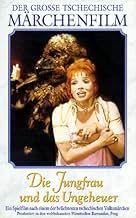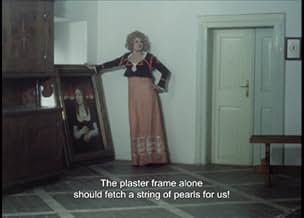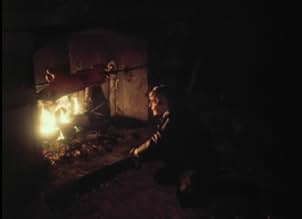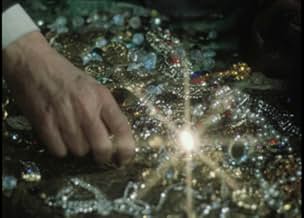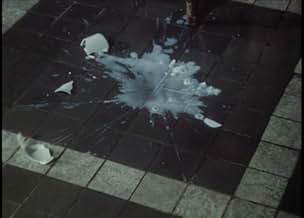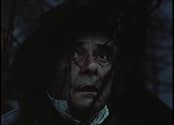VALUTAZIONE IMDb
7,5/10
2103
LA TUA VALUTAZIONE
Aggiungi una trama nella tua linguaIn this gothic rendition of the classic fairy tale, a merchant's youngest daughter is held prisoner by a mysterious winged beast.In this gothic rendition of the classic fairy tale, a merchant's youngest daughter is held prisoner by a mysterious winged beast.In this gothic rendition of the classic fairy tale, a merchant's youngest daughter is held prisoner by a mysterious winged beast.
- Regia
- Sceneggiatura
- Star
- Premi
- 2 vittorie e 1 candidatura in totale
Jorga Kotrbová
- Málinka
- (voce)
Tatjana Medvecká
- Julie
- (voce)
Recensioni in evidenza
This is such a strange film. Nominally a Beauty and the Beast rendition (the title translates to Virgin and the Monster), it is introspective wandering through dreams. It is both rich in what we see of dreams and silly. The filmmaker (Juraj Herz, also responsible for Cremator) juggles various moods, sombre elegy to medieval fairytale.
As you watch it, it may strike you as both obvious and muddled, obvious because its fantasy is of the schematic sort, with onedimensional characters like the 'kindly father', 'innocent maiden', 'petty step- sisters'. The monster looks silly. So it may seem like it's not worth the effort of bridging the distance to what is going on behind the simplistic surface.
However, scrap all that and this may get to you. It got to me, at least for a while. It isn't about just the Gothic mood. Its appeal is a series of interleavened dreams, but you aren't always sure who is dreaming, if sometimes more than one dreamer, and when one bleeds into the next, so you drift with it.
Consider this as the story. A rich merchant father has to marry off his daughter in a marriage of convenience, the anxiety this causes to both is at the root of the film. It isn't in the film as such, but you will get something of the sort if you conflate the different threads.
From the father's perspective, this means sending off his daughter to live with a 'monster' in his dark lair, from her perspective, it means going to live alone with a stranger, her fate sealed. This translates in several scenes of hallucination, all of it wonderfully visual—the ominous destruction of the merchant wares in the woods, the father's deal with the monster for the girl, the girl's gilded dream of a handsome prince (inside a coffin) and half-frightful, half-anticipatory wandering in the mansion hearing just his voice.
The plucking of roses as loss of purity is a central motif.
It's silly again as we shift to the monster's soliloquies of what it means to be human, but that is because we don't have a surrogate for him in the level of reality, he solely exists inside the fantasy as the abstract ogre made human by her touch. The Czech often favor a juvenile theatricality.
But there's something else that is cool. Now so far all points to constructed realities, dreams as tailored emotional space. The girl wonders if she's not imagining everything, in one scene she visits as ghostly observer her sisters' wedding, no one can see her.
Here's how the filmmaker adds layers to the monster. He has conflicting sides to him, two voices that ponder on whether to kill or spare the girl. The 'evil' voice is disembodied, in his mind. This 'evil' narrator is coming from the camera, you'll notice this is linked with subjective shots of the monster as it kills the wench in the woods, roams with a candelabra and early on 'stages' the frightful visit of the father. It's the filmmaker's hand (as internal consciousness shaping the story) pushing for horror, very cool to see.
So as with many films of this sort, the film becomes more disposable the more you settle on what the story is supposed to be. It fits somewhere between Lynch, Hourglass Sanatorium for nested doll-worlds, Jean Rollin's wandering and Valerie's Week of Wonders.
I listed the films (and makers) in descending order of preference, which for me is the order by which, as you peel away layers, you get less and less of what you thought is there, it opens up, instead of a single solid core. Angels dancing instead of a pin's head.
So if you want a cryptic story disguised to mean something, this is cryptic but as with Rollin and Valerie it makes rather simple sense. At the same time, it is dissonant enough once you disengage from story to captivate. I will see if I can track down more from this guy, he may deserve a place in my nightly viewings.
As you watch it, it may strike you as both obvious and muddled, obvious because its fantasy is of the schematic sort, with onedimensional characters like the 'kindly father', 'innocent maiden', 'petty step- sisters'. The monster looks silly. So it may seem like it's not worth the effort of bridging the distance to what is going on behind the simplistic surface.
However, scrap all that and this may get to you. It got to me, at least for a while. It isn't about just the Gothic mood. Its appeal is a series of interleavened dreams, but you aren't always sure who is dreaming, if sometimes more than one dreamer, and when one bleeds into the next, so you drift with it.
Consider this as the story. A rich merchant father has to marry off his daughter in a marriage of convenience, the anxiety this causes to both is at the root of the film. It isn't in the film as such, but you will get something of the sort if you conflate the different threads.
From the father's perspective, this means sending off his daughter to live with a 'monster' in his dark lair, from her perspective, it means going to live alone with a stranger, her fate sealed. This translates in several scenes of hallucination, all of it wonderfully visual—the ominous destruction of the merchant wares in the woods, the father's deal with the monster for the girl, the girl's gilded dream of a handsome prince (inside a coffin) and half-frightful, half-anticipatory wandering in the mansion hearing just his voice.
The plucking of roses as loss of purity is a central motif.
It's silly again as we shift to the monster's soliloquies of what it means to be human, but that is because we don't have a surrogate for him in the level of reality, he solely exists inside the fantasy as the abstract ogre made human by her touch. The Czech often favor a juvenile theatricality.
But there's something else that is cool. Now so far all points to constructed realities, dreams as tailored emotional space. The girl wonders if she's not imagining everything, in one scene she visits as ghostly observer her sisters' wedding, no one can see her.
Here's how the filmmaker adds layers to the monster. He has conflicting sides to him, two voices that ponder on whether to kill or spare the girl. The 'evil' voice is disembodied, in his mind. This 'evil' narrator is coming from the camera, you'll notice this is linked with subjective shots of the monster as it kills the wench in the woods, roams with a candelabra and early on 'stages' the frightful visit of the father. It's the filmmaker's hand (as internal consciousness shaping the story) pushing for horror, very cool to see.
So as with many films of this sort, the film becomes more disposable the more you settle on what the story is supposed to be. It fits somewhere between Lynch, Hourglass Sanatorium for nested doll-worlds, Jean Rollin's wandering and Valerie's Week of Wonders.
I listed the films (and makers) in descending order of preference, which for me is the order by which, as you peel away layers, you get less and less of what you thought is there, it opens up, instead of a single solid core. Angels dancing instead of a pin's head.
So if you want a cryptic story disguised to mean something, this is cryptic but as with Rollin and Valerie it makes rather simple sense. At the same time, it is dissonant enough once you disengage from story to captivate. I will see if I can track down more from this guy, he may deserve a place in my nightly viewings.
What a wonderful film it is. Never having seen it before and only the Cocteau, made in 1946, a couple of times. I know there are many other versions but I think these two will be good enough for me when I like to watch this story again. I didn't really think that this one would be very good but it is amazing. Right from the beginning there is a stunning opening with a forest and a terrible ride with many horses and wagons, in the rain and the mud. Then there are the credits, even more wonderful as surrealist like paintings almost animated, unusual and original. Then back to the forest, the peasants have taken the wrong turning and they are lost but there is fire and horror. In the village and the man and his three girls with two of them getting married but he gets word that the wagons and their treasures and spices are lost and he will not make his money. There will be no wedding. He goes into the forest with his painting of his dead wife all seems to be okay and later with the third daughter she has to go into that gothic ruin in the forest and maybe find a husband. We know the story well enough but with this one and the beast or monster or her lover it is really well done and thrilling and beautiful to watch it all the time throughout. Breathtaking.
The honest merchant Otec (Václav Voska) goes bankrupt when he loses the cargo of dowry for the wedding of his ambitious and envious older daughters Málinka (Zuzana Kocúriková) and Gábinka (Jana Brejchová) with decadent earls. His only chance to raise money is selling the painting of his former wife and mother of the sweet and pure youngest daughter Julie (Zdena Studenková). He travels through the Haunted Wood during the night, but his horse dies and he seeks shelter in the derelict castle of the Beast (Vlastimil Harapes). He is well received by his host that buys his painting by a fair price. When he is leaving the castle, he takes a rose for Julie from the Beast's rosebush and his host tells that he must pay with his life for the theft of the rose. He asks for permission to return home to give the jewels for his daughters, but he would return to the castle since he is a man of honor. The Beast accepts and tells that his life would be spared whether one of his daughters agrees to come to the castle. When Julie learns the proposal, she travels to the castle to save the life of her father. She is forbidden by the Beast to look at him, but along the lonely days, she falls in love with his voice and kindness.
"Panna a netvor" (1978), a.k.a. "Beauty and the Beast", is a dark version from Czechoslovakia of the classic fairy tale. The plot is flawed, since the curse and the magic of the beast are not explained, and ambiguous, since the conclusion is not sure that is the reality or the beautiful view of the ugliness of Julie. The performances, lighting and shadows are magnificent. My vote is seven.
Title (Brazil): "A Bela e a Fera" ("The Beauty and the Beast")
"Panna a netvor" (1978), a.k.a. "Beauty and the Beast", is a dark version from Czechoslovakia of the classic fairy tale. The plot is flawed, since the curse and the magic of the beast are not explained, and ambiguous, since the conclusion is not sure that is the reality or the beautiful view of the ugliness of Julie. The performances, lighting and shadows are magnificent. My vote is seven.
Title (Brazil): "A Bela e a Fera" ("The Beauty and the Beast")
I saw this film many years ago at Filmex in Los Angeles, and it left a strong impression. It is a truly beautiful version of the fairy tale Beauty and the Beast. It is a real shame that Herz's films are not available today, at least to US cinephiles.
I remember this film as having been done in a very naturalistic way, with (I think) no optical effects at all. The costumes were wonderful, as was the music and the acting. It seems to me there was a situation in which a woman's dress turned to mud (in a simple jump cut). The "Beast" is especially striking, with his bird-like plumage.
Anyone at Facets want to take this one on?
I remember this film as having been done in a very naturalistic way, with (I think) no optical effects at all. The costumes were wonderful, as was the music and the acting. It seems to me there was a situation in which a woman's dress turned to mud (in a simple jump cut). The "Beast" is especially striking, with his bird-like plumage.
Anyone at Facets want to take this one on?
It's difficult to get past the opening scenes of close-ups of animal abuse, but at least that sets the tone for this very dark and murky adaption of the famous story. They say the acting life can be very glamorous - it certainly isn't the case here. No CGI safety-net, the performers attached to this story certainly seem to suffer for their art in a variety of uncomfortably cold situations.
It's good when horror films bring some new locations into their stories, but equally, it's always worth it to revisit the vast crumbling lairs of traditional settings, and that is done really effectively here; the story is given the most impressive horror treatment. Creatures hide in shadow - you only know they're there when you see a rolled eyeball or a moving, inhuman talon. There is enough of a fairytale quality to this to appeal to the inner child, and there are moments when the eyes will moisten! It's all accompanied by wonderful, sepulchral music, and directed like a hugely gothic TV film. My score is 8 out of 10.
It's good when horror films bring some new locations into their stories, but equally, it's always worth it to revisit the vast crumbling lairs of traditional settings, and that is done really effectively here; the story is given the most impressive horror treatment. Creatures hide in shadow - you only know they're there when you see a rolled eyeball or a moving, inhuman talon. There is enough of a fairytale quality to this to appeal to the inner child, and there are moments when the eyes will moisten! It's all accompanied by wonderful, sepulchral music, and directed like a hugely gothic TV film. My score is 8 out of 10.
Lo sapevi?
- QuizThe beast looks like a bird in this version.
- BlooperWhen the father is travelling with the painting, a crow flies out from behind a log. A crew member's hands can be seen throwing the bird upward.
- ConnessioniFeatured in Predcasná úmrtí: Bozský skeptik (2001)
I più visti
Accedi per valutare e creare un elenco di titoli salvati per ottenere consigli personalizzati
- How long is Beauty and the Beast?Powered by Alexa
Dettagli
- Data di uscita
- Paese di origine
- Lingua
- Celebre anche come
- Beauty and the Beast
- Azienda produttrice
- Vedi altri crediti dell’azienda su IMDbPro
Contribuisci a questa pagina
Suggerisci una modifica o aggiungi i contenuti mancanti

Divario superiore
By what name was Giulia e il mostro (1978) officially released in India in English?
Rispondi
